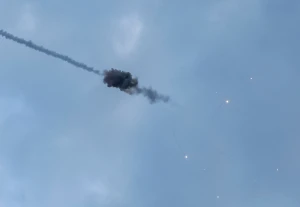
Ukraine launches second major attack on Russian targets in September. Serhiy Zgurets' column
Ukrainian drones hit targets in nine Russian regions, including Moscow. Russia claimed to shoot down 144 drones, indicating the actual number was higher
Ukrainian drone attack on Russia
Yesterday, September 10, there were two drone attacks, but our focus is on Ukraine's. For the second time in September, Ukraine conducted a large-scale attack on Russia's military and critical infrastructure, in nine regions of the country, along with Moscow. The attackers used Lutyi drones with a range of over 1,000 kilometers and a warhead weight of 50 kilograms.
The Russian Defense Ministry reported shooting down 144 drones, indicating the actual number was much higher. We will await satellite images to assess the effectiveness of Ukrainian drones on Russian targets. Preliminary reports suggest strikes were made on Zhukovsky, home to several key defense and technology facilities in Russia.
All three civilian airports in Moscow were closed. One runway caught fire due to drones being downed by either air defense or electronic warfare systems. Some drones fell on the city of Ramenskoye, causing fires in high-rise buildings.
Together with Ukrainian operations in the Kursk region, these drone attacks are an important element of psychological pressure on the Russian population, combined with specific practical tasks of destroying the Russian defense and critical infrastructure.
Effective work of Ukrainian air defense system
On the night of Tuesday, September 10, Russian aggressors launched a Shahed drone attack aimed at Ukraine's energy infrastructure. According to the Air Force Command, 38 out of 46 drones were destroyed, indicating high effectiveness of Ukrainian air defense. However, it's crucial to remember that downing each target requires the coordination of SAM systems, aviation, and mobile units. Maintaining a balance between the cost and value of the intercepted target is essential, and it seems that the Ukrainian Armed Forces have a coherent approach to air defense.
New data from U.S. defense industry
The Pentagon has released data on weapon production rates comparing 2022 and 2024, available on the U.S. Department of Defense website. While the report includes numerous metrics, you’ve highlighted a few key points of interest for both Ukrainian and American military needs.
In particular, we are talking about GMLRS missiles for HIMARS. As of the end of the summer of 2024, they are already being produced monthly in the amount of 1167 units, which is 40% more than in 2022. We produce 8 launchers for HIMARS per month, compared to 6 previously. We know that there is now a significant demand for HIMARS and these missiles in a number of countries other than Ukraine itself.
The Pentagon also reported that during this time, from 2022 to 2024, the production of Patriot anti-aircraft missiles, which can intercept ballistic targets, doubled. But the production of these missiles per month is 42 missiles. This is not very much, especially given the effectiveness and intensity of the use of such missiles, in particular by Ukraine. There are also significant orders in other countries for these types of missile defense.
Of course, the most relevant is the production of 155 mm ammunition. According to a Pentagon report, the United States is currently producing 40,000 155 mm artillery rounds per month. Compared to 2022, this is a 178% increase, as back then the Americans produced only 14,500 shells per month.
But there are nuances here. It turns out that 40,000 shells are produced, but charges are still needed, i.e. powders that push the shell through the gun barrel. The production of these charges for shells is much smaller, and only 18 thousand are produced per month. The growth here is small. The main acceleration is now underway to ensure that at least 40,000 shells and charges are produced per month to bring the production of charges up to the number of shells.
One more nuance. The data announced by the Pentagon yesterday is somewhat less than previously announced by the US Department of Defense itself. They said that for this period, in the fall of 2024, they should reach the production of 80 thousand shells per month, and in 2025 - 100 thousand shells per month. I hope that the Americans will meet these more optimistic figures and will be able to really increase the need for shells, which is now essential for the Ukrainian Armed Forces.
On September 8, General Syrskyi said that the ratio of Russian shells used on the battlefield to Ukrainian shells is now 1:2. I hope that this is also a somewhat optimistic statement, but even if it is 1:3, it is very good. Because when the Russians were capturing Avdiivka, they had a 1:10 advantage in ammunition.
Countering Russian air strikes
And next, we will talk about the development of the air defense system. We will talk about certain dynamics in this area, where we need both foreign assistance and our own efforts.
At the 24th Ramstein meeting, U.S. Secretary of Defense Lloyd Austin stated in his speech that the U.S., in cooperation with several European countries, is working on replacing the S-300 air defense systems used by the Ukrainian Armed Forces, as well as the R-27 missiles.
Ihor Romanenko, Deputy Chief of the General Staff of the Armed Forces of Ukraine (2006-2010), Lieutenant General, founder of the Close the Skies of Ukraine Charitable Foundation, believes that today our partners are looking for different ways to become more effective in armament. “About a year ago, the FrankenSAM program was launched, when missiles from Kubs and Buks were adapted to Ukrainian old air defense systems, and there were developments on the S-300 system. But this is not enough, because we see what large-scale air strikes the Russians are conducting, so our allies are looking for opportunities in these areas.
The lieutenant general noted that Ukrainian defense companies are making significant efforts. Ukraine has had a missile program since 2022. It is known that there is a second version of the Neptune modernization, the Palianytsia has appeared, and a ballistic missile has been tested. That is, we are moving forward, but we need everything, as they say, yesterday. The Ukrainian defense industry is working with relevant allied companies to find solutions that are being implemented in specific developments in air and missile defense.
The founder of the Close the Skies of Ukraine Charitable Foundation commented on Iran's Fath-360 missiles, noting that there are two ways to combat guided bombs. The first one is to use surface-to-surface weapons, i.e. to strike at depots, launchers and airfields where the carriers are located. The second is that if the missiles are already launched, they can be destroyed by anti-missile systems with anti-missile capabilities. Unfortunately, we have few such SAMs, including Patriot and SAMP/T. Since the beginning of 2024, President Zelenskyy has been fighting for seven batteries, while German SAMs have arrived, and there are no reports of American SAMs. Iranian missiles are of better quality than North Korean ones, and the Iranians are now making excuses that they need grain. So far, we are talking about Iranian missiles with a short range of up to 120 kilometers.
The former Deputy Chief of the General Staff of the Armed Forces of Ukraine said that our FPV drones destroy Russian reconnaissance drones and also hit enemy helicopters. We are now practicing to destroy or damage Russian attack drones with our FPVs. We remember that Ukrainian light aircraft in Mykolaiv and Kherson regions also destroyed drones. Accordingly, we need to continue to develop and increase the means of countering Russian air attacks.
- News













































